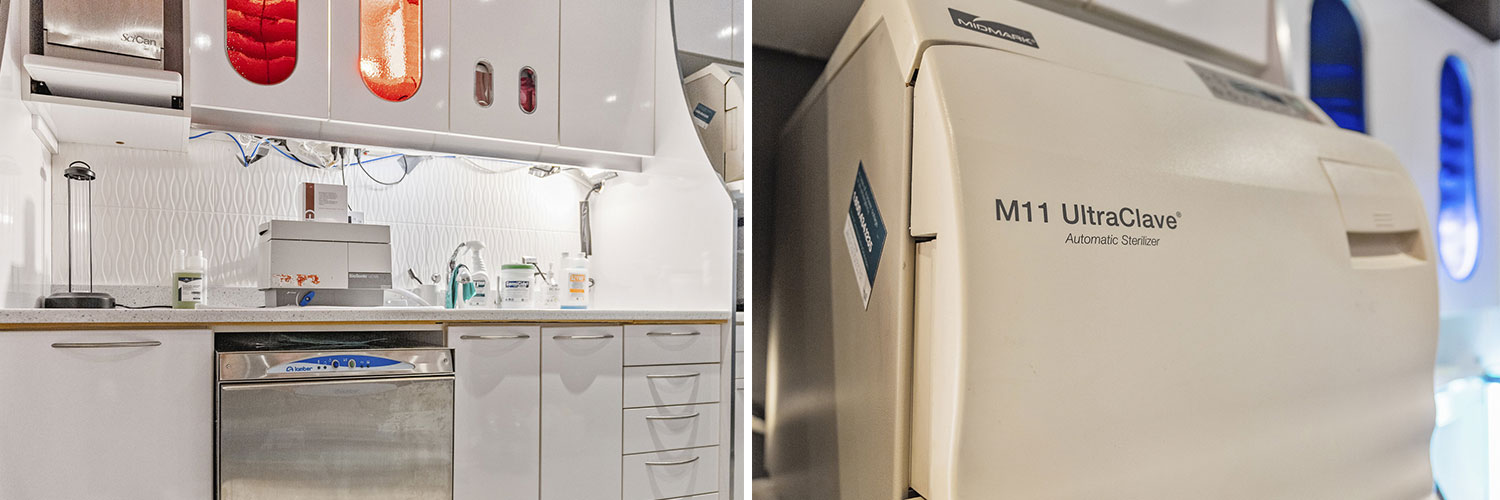Infection Control
Commitment to RCDSO Standards for Infection Prevention and Control
A sworn commitment by Dr. Rita Kilislian for the patients of her practices. At the core of Dr. Rita Kilislian’s practices, we are firmly committed to continually striving to exceed the standards set by the Royal College of Dentists of Ontario (RCDSO) for infection prevention and control.
Dr. Kilislian, a certified endodontist since 1997 with concurrent registrations in CBCT and oral moderate sedation, ensures that every aspect of the practice adheres to the highest standards of safety and sterilization, and she with experts in the field plays an active role in the implementation and continual assessment of these protocols.
Since opening many years ago our dedication to these norms transcends into the use of advanced sanitization and disinfection technology like high-intensity UV disinfection. This technology rids the environment of pathogens, thus promoting a risk-free dental experience for our patients.
But we need to go further, and hence we do. Sterilization is a continuous process with many steps, and a lot of nuances. Hence our equipment employees digital record keeping, direct into patient records time locked. We employ Ultrasonic baths for thorough cleaning of instruments, supplemented by meticulous washing in 195-degree instrument washing cycles PH balanced Scican detergent-loaded cassettes. An additional layer of safety and hygiene is maintained by using cassettes where possible, ensuring the instruments stay sterilized until ready for use without a perforation of the pouch. Chemical indicators and visual inspection are key.
As well as regular training on reprocessing of instruments- and the latest and greatest in IPAC advancements. At our clinic, we lean heavily on disposable or single-use instruments. This practice significantly reduces the risk of cross-contamination. When traditional instruments are utilized, they are cleaned and disinfected with copious amounts of sodium hypochlorite, adding another layer of protection.
Documentation forms an integral part of our commitment to safety. Our workflow incorporates exhaustive documentation into each patient’s record, from sterilization indicators to individual treatment details. We use biological indicators and Class 4 and 5 sterilization standards, overseen by a team of three personnel, including Dr. Kilislian. Every instrument or file is only opened in her direct presence, ensuring meticulous sterilization and sanitation protocol adherence. Video recording of all procedures is regularly done, safeguarding against any potential compromise on health information.
We believe in accountability and maintain detailed records with extensive information to ensure optimal patient care and infection control. Our team is committed to continuous learning and updating their knowledge. This dedication led to our facility becoming a training partner with Scican, a leader in infection control and sterilization. We work closely with renowned authorities like Dr. John Hardie, an Oral Pathologist, and PHD holder on the transmission of bloodborne viruses. We also invite frequent independent audits from leading Infection Prevention and Control (IPAC) experts such as Sarah Barradas, BSc, Phs-ed, RRDH, MBA, microbiologist Dean Swift, and Dr. Kevin Katz, an infectious disease specialist at North York General. These leading experts inspect our facility and processes, validating our commitment and dedication to patient’s safety and infection control.
The proof of our commitment lies in concrete data points, demonstrated through charts, graphs, and grids which we prominently display for reassurance of our impeccable standards. As the Chief Dental Officer and the Specialist on Site of my practices, we wish to assure our patients that their safety and health are our top priority. We pledge to continue maintaining and enhancing these infection prevention and control practices for excellence in patient care.
In addition to the aforementioned measures, we have implemented state-of-the-art HVAC systems equipped with negative air ionizers in every treatment room. These bespoke systems contain UV lighting with a capacity of 400 watts per surgical treatment suite to ensure maximum pathogen removal. Moreover, HEPA filters are placed throughout the entire unit, supported by supplementary air scrubbers, enhancing the air quality for both our patients and the team.
Our diligent attention also extends to maintaining the cleanest possible water. We employ a complex water treatment process, encompassing reverse osmosis, meticulous filtering, UV irradiation, and regular shocking of dental lines. After every patient engagement, we purge the lines for three full minutes to eliminate any potential contamination.
For additional safety, instruments are quarantined for a period of seven business days between uses. This practice, though time-intensive, is a testament to our absolute commitment to minimizing any conceivable infection risk.
A hallmark of our practice is the transparency with which we operate. All records, without exception, have been up-to-date and readily available for review since the inception of our Water Street clinic in Peterborough. Providing full access to our operational and patient data reflects our accountability and commitment to patient safety.
We would like to emphasize that any claims or implications deviating from these rigorous standards and practices we maintain are categorically false. While misinformation can occasionally circulate, our unwavering pledge to RCDSO standards for infection prevention and control, combined with our stringent measures, remain deeply rooted in our commitment to our patients’ wellbeing.


